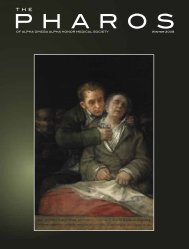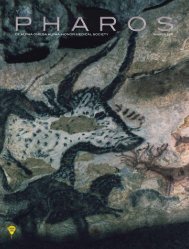4 - Alpha Omega Alpha
4 - Alpha Omega Alpha
4 - Alpha Omega Alpha
Create successful ePaper yourself
Turn your PDF publications into a flip-book with our unique Google optimized e-Paper software.
homestead, and the sheriff and the rest head off as a decoy<br />
as if transporting Wade themselves. There are some excellent<br />
scenes around supper, the saying of grace, and Evans cutting<br />
the handcuffed Wade’s meat (no fat, please). Wade becomes<br />
acquainted with Alice and begins to get some insight into their<br />
family. The rest of the film involves their arrival in Contention<br />
and the interplay between Evans and Wade in the hotel’s bridal<br />
suite as they wait for the train. Two significant events, the saving<br />
of Wade by Evans and the arrival of Alice, set the scene for<br />
the well- choreographed and dramatic ending in which Evans<br />
must get Wade to the train as the gang positions itself to rescue<br />
Wade and kill Evans.<br />
3:10 to Yuma (2007)<br />
Starring Russell Crowe, Christian Bale, Peter Fonda, and Ben<br />
Foster.<br />
Directed by James Mangold. Rated R. Running time 122 minutes.<br />
The re-make, which is a half-hour longer than the original<br />
(and feels it) differs significantly. It opens with the Evans<br />
barn being burned by the banker’s hooligan. The elder Evans<br />
son William (Logan Lerman) expresses disdain for his father<br />
Dan Evans (Christian Bale) because he won’t do anything but<br />
simply grovel for more time before foreclosure. While they<br />
go to round up the cattle, they come upon the robbery of the<br />
stagecoach, this time loaded with paper currency, not gold,<br />
and with a lot more shooting and killing. The stage is carrying<br />
Pinkerton detectives, one of whom, Byron McElroy (Peter<br />
Fonda), is Ben Wade’s (Russell Crowe) nemesis. Wade shoots<br />
McElroy in the abdomen at point-blank range. As in the original,<br />
Wade spares the Evans family and heads for Bisbee where<br />
he is captured after dallying with the barmaid Emma Nelson<br />
(Vanessa Shaw). The filmmakers felt compelled to sprinkle in<br />
some profanity, which adds nothing to the dialogue, as well as<br />
partial nudity. The liaison between Wade and the barmaid was<br />
handled off-screen in 1957. There is a medical sidebar when<br />
McElroy is operated on without anesthesia by veterinarian<br />
Doc Potter (Alan Tudyk). Simply removing the bullet leads to<br />
a remarkable recovery and McElroy joins Evans, Doc Potter,<br />
and Butterfield the stagecoach owner (Dallas Roberts) in<br />
transporting Wade to Contention.<br />
The supper at the Evans homestead is more crowded and<br />
not as much a family event. Evans still cuts the handcuffed<br />
Wade’s meat but this time he’s asked to cut off the gristle. We<br />
also learn more about Evans’s Civil War record and that he<br />
lost a leg (not so in the original). Nonetheless, he is able to<br />
run like a deer in some key scenes. From here, the re-make<br />
diverges widely from the original as the film covers the trip<br />
to Contention, which the original did not. There’s a lot more<br />
violence, special effects, and issue- oriented dialogue that the<br />
director acknowledges in the DVD commentary was intentional.<br />
This includes vilifying the Pinkertons for presumably<br />
slaughtering Apache women and children, as well as the railroad’s<br />
exploitation of Chinese and Negroes. In contrast to the<br />
low-key performance by Richard Jaeckel as Charlie Prince,<br />
Wade’s second-in- command, in the original, Ben Foster gives<br />
a riveting performance as a vicious psychopath who is dedicated<br />
to Wade, although the feeling is not mutual. While I’m<br />
not a fan of psychopaths, Foster’s portrayal, which is reminiscent<br />
of Richard Widmark’s performance in The Killers, was,<br />
for me, the highlight of the movie.<br />
Evans’s wife is no longer involved in the ending, which<br />
is much different from the original although the last line is<br />
virtually the same. Director Mangold decided to drop her<br />
(whose role I much preferred) and made the elder son a main<br />
character. Both play the same role in humanizing Wade as he<br />
builds an appreciation of Evans and the importance of trying<br />
to preserve him for his family’s sake. In this version, Wade<br />
quotes the Bible, as many movie villains do these days. He<br />
confesses that his mother left him in a hotel room with a Bible<br />
and promised to return. He read it in three days, but she never<br />
came back for him. His favorite quotations are from Proverbs<br />
13:3 and 21:2. Crowe appears at times to be sleepwalking<br />
through the picture, but to give him his due, he does convey<br />
menace in ways that Glenn Ford did not in the earlier version.<br />
As Wade says to Matthew, who is enamored of Dime Novel<br />
western desperadoes like himself, “Kid, I couldn’t last five<br />
minutes leading an outfit like that if I wasn’t rotten as hell.”<br />
Yet he’s an artist and a philosopher, the prototypical post-’60s<br />
anti-hero. His exchange with Evans as to why he doesn’t do<br />
good deeds is particularly noteworthy.<br />
As one might expect of someone who came of age in the<br />
1950s, I much preferred the original, which features straightahead<br />
storytelling with a powerful performance by Van<br />
Heflin, who specialized as the solid second male co-star, most<br />
especially in Shane. Leora Dana’s role, though smaller, is essential<br />
in conveying the importance of character and family.<br />
Still, as noted, there are some excellent scenes and standout<br />
performances in the re-make, especially by Ben Foster, as well<br />
as Peter Fonda. I was also grateful for the re-make in that it<br />
led me to watch the older version. There are some interesting<br />
features on the DVD, especially the one that shows how the<br />
picture was made. Another, an altogether too brief survey<br />
of the Western outlaws gangs like the James Brothers, the<br />
Youngers, the Daltons, and the Earps, discusses how many of<br />
them walked the fine line between being lawmen and outlaws,<br />
periodically falling to one side or the other.<br />
Dr. Dans (AΩA, Columbia University College of Physicians and<br />
Surgeons, 1960) is a member of The Pharos’s editorial board and<br />
has been its film critic since 1990. His address is:<br />
11 Hickory Hill Road<br />
Cockeysville, Maryland 21030<br />
E-mail: pdans@comcast.net<br />
The Pharos/Spring 2009 41














